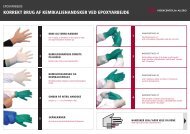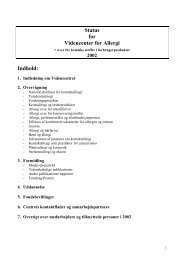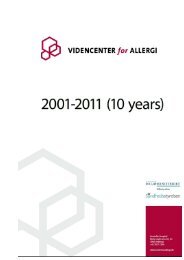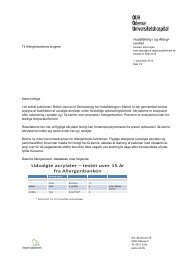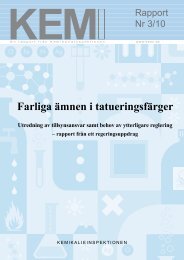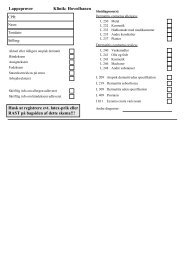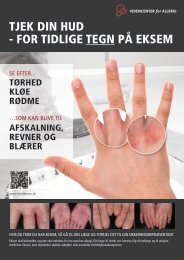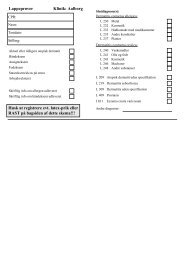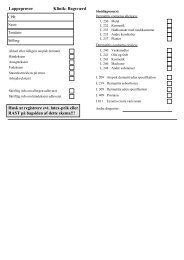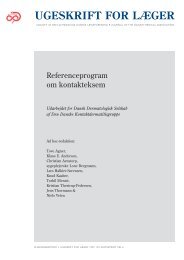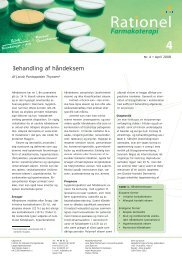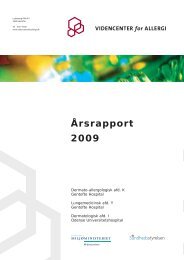Charlotte Devantier Jensen.pmd - Videncenter for Allergi
Charlotte Devantier Jensen.pmd - Videncenter for Allergi
Charlotte Devantier Jensen.pmd - Videncenter for Allergi
You also want an ePaper? Increase the reach of your titles
YUMPU automatically turns print PDFs into web optimized ePapers that Google loves.
Contact allergy to the preservative methyldibromoglutaronitrile 15<br />
EXPERIMENTAL WORK –<br />
STUDY DESIGN, RESULTS AND DISCUSSIONS<br />
In the following section, the findings of the thesis are described.<br />
Due to the division of the project into 3 separate clinical trials,<br />
it would be inconvenient to compile all in a common section.<br />
To ensure clarity, a description of each trial, including a discussion<br />
of the findings, is given separately. A general discussion<br />
and future perspectives will follow.<br />
TRIAL I – ELICITATION STUDY OF MDBGN IN A<br />
RINSE-OFF PRODUCT<br />
A double-blind, randomized experimental model imitating the<br />
use of an MDBGN-containing rinse-off product was developed<br />
based on the ROAT method. 19 subjects with a positive<br />
patch test reaction to MDBGN were asked to wash areas of<br />
skin on their <strong>for</strong>earms measuring 5×10 cm with liquid soaps.<br />
The test area on one arm would be washed with a liquid soap<br />
containing 0.1% MDBGN and the other with a soap without<br />
MDBGN. This would be done twice a day <strong>for</strong> up to 4 weeks or<br />
until dermatitis developed on the test area. A control group of<br />
9 individuals with negative patch test reactions to MDBGN<br />
also per<strong>for</strong>med the use test.<br />
Of the 19 participants, 7 (37%) developed dermatitis on the<br />
test area after 6 to 34 days. 2 individuals agreed to continue<br />
the use test <strong>for</strong> a fifth week, because they described a slight<br />
itching on one test area on the final day of the test. One of<br />
these subjects developed a positive reaction after 34 days on<br />
the MDBGN-exposed arm. The other developed a few square<br />
centimetres of weak dermatitis, but did not fulfil the criteria<br />
<strong>for</strong> a positive response. An example of a positive use test is<br />
shown in Fig. 5 (p. 17), and test results <strong>for</strong> all participants can<br />
be seen in Table 4. All 9 controls had negative use tests.<br />
Table 4. Test results of use test with rinse-off product containing 0.1% MDBGN.<br />
The frequency of positive use test reactions to the MDBGNcontaining<br />
soap was significantly different between the test<br />
group and the control group (one-sided Fischer’s Exact Test, p<br />
= 0.04). The average amount of soap used per application varied<br />
considerably among the test subjects with the range 0.019g<br />
to 0.29g (Table 5). However, the corresponding use in the control<br />
group was similar with the range 0.018g to 0.28g. Considerable<br />
inter-individual variation in exposure was noted because<br />
some participants deliberately widened the opening of the soap<br />
container to ease the application of the soap resulting in application<br />
of larger amounts.<br />
The dose per unit area of exposure in the test group was<br />
estimated to a mean of 2.2 µg/cm 2 MDBGN per application,<br />
and the 7 subjects with a positive response averagely applied a<br />
summed total of 35 µg/cm 2 in the test period (Table 4). For<br />
comparison, in a time-dose-response study in sensitized volunteers<br />
with the potent fragrance allergen isoeugenol, the total<br />
amounts of allergen applied in a use test be<strong>for</strong>e positive<br />
responses developed were averagely 66 and 144 µg/cm 2 <strong>for</strong> a<br />
low and a high dose of isoeugenol, respectively 8 . It must be<br />
taken into account that this was leave-on test material with a<br />
greater skin contact than in the current experiment, where some<br />
of the soap and allergen was washed off the skin shortly after<br />
application. However, it is also important to consider the presence<br />
of detergents in the soap as they may influence the<br />
elicitation and induction thresholds and the tendency of the<br />
skin to develop contact dermatitis 22,82 . Soaps have irritating<br />
properties, <strong>for</strong> instance due to the detergent sodium lauryl sulphate<br />
(SLS), and may cause unspecific inflammatory reactions<br />
and increase penetration into the skin. Pedersen et al 83 demonstrated<br />
an augmented allergic response in sensitized patients<br />
when patch tested with MDBGN combined with SLS com-<br />
Patch test threshold Patch test reaction Day of positive Average amount of MDBGN applied<br />
concentration to MDBGN ROAT MDBGN per until positive<br />
Pt (MDBGN eth./aq.) 0.3% pet. application(µg/cm 2 ) ROAT (µg)<br />
1 0.02% ++ - 4.3 -<br />
2 0.1% + - 4.6 -<br />
3 0.2% + - 4.2 -<br />
4 0.005% ++ - 1.3 -<br />
5 < 0.001% ++ 11 1.0 20<br />
6 < 0.001% ++ - 0.74 -<br />
7 0.1% + - 0.38 -<br />
8 < 0.001% ++ 15 1.0 29<br />
9 < 0.001% +++ 6 1.0 11<br />
10 < 0.001% ++ - 4.2 -<br />
11 0.2% +? - 2.6 -<br />
12 0.2% neg 23 3.9 171<br />
13 0.003% ++ 12 0.54 12<br />
14 < 0.001% + - 1.0 -<br />
15 0.05% + - 0.89 -<br />
16 0.05% ++ 13 2.8 66<br />
17 0.01% +? - 5.5 -<br />
18 < 0.001% ++ 34 0.83 55<br />
19 0.2% neg - 1.4 -<br />
Neg = negative, Pt = patient, < = below.<br />
Forum <strong>for</strong> Nord Derm Ven Vol. 10, 2005 – Suppl. 8




